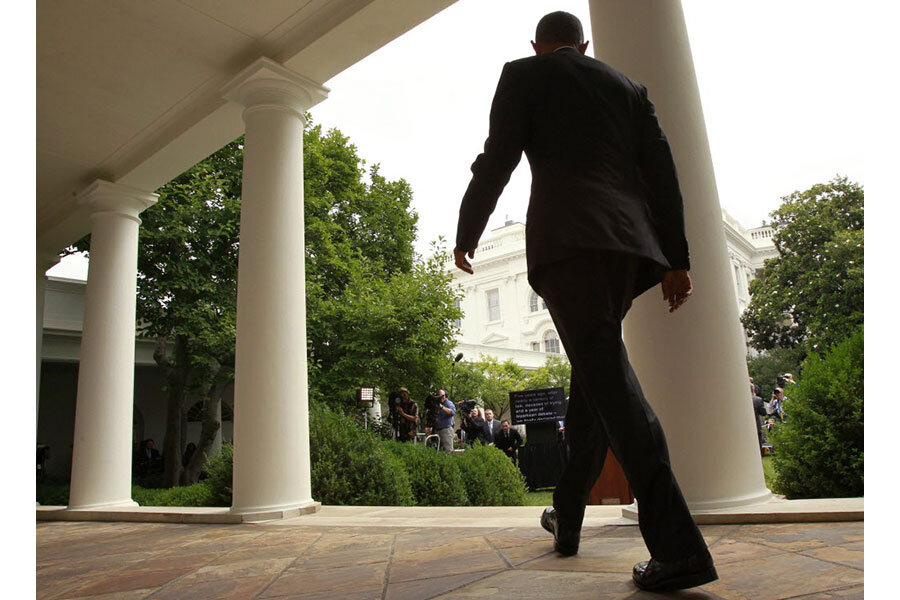This week, a glimpse of a different President Obama
Loading...
| Washington
President Obama has often been accused of being missing in action on Capitol Hill – not a schmoozer, not eager to put in the personal time with lawmakers to advance his priorities. But as described by Sen. Ron Wyden (D) of Oregon, Mr. Obama’s point person on trade in the Senate, “the president was all-in on this issue.”
No question, the president’s trade agenda took tremendous bipartisan effort to shape and pass. Senator Wyden took care to praise Republican leaders who he said were always “straight” with him. They rescued the trade package from a surprise derailment by House Democrats earlier this month. The president, too, applauded Republicans and Democrats for "coming together" on trade.
But it was Democrats who held the key to this presidential priority. Most Republicans in the GOP-controlled Congress may have agreed with Obama on trade, but not enough of them did. To win this signature item, Obama was going to have to win and hold some Democrats, and that was going to take persistent outreach and a convincing argument.
In the end, “gutsy” pro-trade Democrats in both houses stuck together despite pressure to abandon a deal, Wyden said. And a “very determined president” used the bully pulpit to explain how his approach differs from trade policy of the 1990s, which many Democrats blame for lost jobs and lower wages.
His articulation of his policy “was a very significant help” as was his outreach to Congress, Wyden told reporters Wednesday.
The result was the passage of two trade bills by the Senate Wednesday. The first, called fast track, means that Congress cannot amend any trade bill the president negotiates – it can only vote up or down. The second provides assistance for workers displaced by global trade. Both bills have now passed both houses, and together, they are one of Obama’s major second-term priorities. He intends to use the authority to negotiate a historic trade deal with 11 other Pacific Rim nations.
To get to this point, the president put in hours on the phone with Wyden, at times talking two or three times a day, working out the next day’s strategy in 11 p.m. phone calls. And he stayed in touch with the GOP leadership.
But he also reached out to other lawmakers. Sen. Chris Coons (D) of Delaware says the president’s outreach persuaded him to vote “yes.”
In the five years since he’s been a senator, Senator Coons says he’s never had as much engagement with the White House on any issue as on trade. For months, the senator debated and discussed trade with the secretary of Labor, the secretary of Commerce, the US trade representative, the vice president, and yes, even the president.
Coons says he gave “comparable” time to labor and environmental leaders who strenuously oppose the president’s push for a Pacific trade deal.
But his mind was changed by the administration’s argument that the United States has an opportunity to positively influence the rules of global trade and strategic relations in the Pacific. He attributed Wednesday’s narrow Senate passage of “fast track” – with not one vote to spare – to the “personal, relentless, and effective” lobbying of senators by Obama and his cabinet.
“I think that frankly is what made the difference,” said Coons in an interview after the 60-to-38 vote that sent the bill to the president’s desk for signature.
Obama's outreach to members didn’t always work. His unexpected show at a congressional softball game on the eve of a key House vote set tweets aflutter, but not the hearts of opposing Democrats. The next morning, his rare visit to Capitol Hill didn’t dissuade them from killing his plan through an unusual move.
But Republican leaders found a way around that "procedural snafu," as Obama's spokesman called it, and the president persisted.
“He threw himself into it…. He would not take ‘no’ for an answer,” says presidential scholar Martha Joynt Kumar, adding that Obama used every lever that a president has for influence, and he used them simultaneously.
Not that he wasn’t also very involved in the priority of his first term, the Affordable Care Act. But with the ACA, she says, he waited for people on the Hill to make decisions. This time, he moved directly.
“In 6-1/2 years, you bring to bear the lessons you have learned, and he did that.”
Whether Obama can carry that forward to the rest of his agenda – infrastructure, corporate tax reform, immigration, the budget, and an Iran deal (if there is one) – is another matter.
He was able to pursue fast track because it aligned with the interest of Republicans. But the president and GOP leaders clash on many of these other issues, particularly over spending.
Meanwhile, the Democratic rift over trade has spilled into the presidential race, with Hillary Clinton waffling on her views of the Pacific trade deal. She supported it when she was the president's secretary of State.
On Thursday, Obama was clearly trying to heal the rift.
“As president, I've spent the last 6-1/2 years fighting to grow our economy and strengthen our middle class, and that remains my top priority today,” he said in his statement. The new trade legislation will give workers “the chance to compete and win.”






